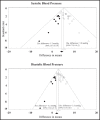The efficacy and safety of triple vs dual combination of angiotensin II receptor blocker and calcium channel blocker and diuretic: a systematic review and meta-analysis
- PMID: 23458592
- PMCID: PMC8033943
- DOI: 10.1111/jch.12040
The efficacy and safety of triple vs dual combination of angiotensin II receptor blocker and calcium channel blocker and diuretic: a systematic review and meta-analysis
Abstract
Many hypertensive patients require ≥2 drugs to achieve blood pressure targets. This study aims to review and analyze the clinical studies conducted with dual or triple combination of angiotensin II receptor blockers (ARBs), calcium channel blockers (CCBs), and diuretics. Medical literature between January 1990 and April 2012 was reviewed systematically and data from eligible studies were abstracted. Data were analyzed using random-effects models. Of the 224 studies screened, 7563 eligible patients from 11 studies were included. Triple combinations of ARBs (olmesartan or valsartan), CCBs (amlodipine), and diuretics (hydrochlorothiazide) at any dose provided more blood pressure reduction in office and 24-hour ambulatory measurements than any dual combination of these molecules (P<.0001 for both). Significantly more patients achieved blood pressure targets with triple combinations (odds ratio, 2.16; P<.0001). Triple combinations did not increase adverse event risk (odds ratio, 0.96; P=.426). Triple combinations at any dose seem to decrease blood pressure more effectively than dual combination of the same molecules without any remarkable risk elevation for adverse events. Further prospective studies evaluating the efficacy and safety of triple combinations, especially in the form of single pills, are required.
© 2012 Wiley Periodicals, Inc.
Figures




References
-
- Kearney PM, Whelton M, Reynolds K, et al. Worldwide prevalence of hypertension: a systematic review. J Hypertens. 2004;22:11–19. - PubMed
-
- Stason WB. Hypertension: a policy perspective, 1976–2008. J Am Soc Hypertens. 2009;3:113–118. - PubMed
-
- Mancia G, De Backer G, Dominiczak A, et al. 2007 ESH‐ESC practice guidelines for the management of arterial hypertension: ESH‐ESC task force on the management of arterial hypertension. J Hypertens. 2007;25:1751–1762. - PubMed
-
- Chobanian AV, Bakris GL, Black HR, et al. Seventh report of the joint national committee on prevention, detection, evaluation, and treatment of high blood pressure. Hypertension. 2003;42:1206–1252. - PubMed
-
- Black HR. Triple fixed‐dose combination therapy: back to the past. Hypertension. 2009;54:19–22. - PubMed
Publication types
MeSH terms
Substances
LinkOut - more resources
Full Text Sources
Medical
Miscellaneous

